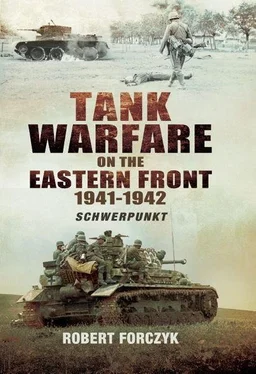The ability of the panzer divisions to achieve decisive operational-level success in the Soviet Union rested squarely on the ability of the corps- and army-level logistical echelons to sustain the panzer spearheads with fuel and ammunition, as well as replacement crews and vehicles. However, the German logistical system was not robust enough to conduct a protracted campaign in the Soviet Union, over vast distances and in all weather conditions.
A 1941 panzer division required one V.S. ( Verbrauchssatz ) of fuel, equivalent to 125cbm (m 3) [6]or 125,000 liters or 92.3 tons, to move all of its vehicles a distance of 100km on roads. German doctrine specified that each panzer division needed four V.S. of fuel stockpiled in order to begin an offensive, which would give it a theoretical range of 400km, although the poor state of Russian roads meant that one V.S. was often only sufficient to move a division 40–50km. In order to reach distant objectives such as Moscow or the eastern Ukraine, the Germans would require dozens of V.S. for each panzer division. However, the logistical capabilities of the Wehrmacht were grossly insufficient for an operation on this scale. The Third Reich perennially suffered from inadequate fuel production and even a short duration campaign on the scale of Operation Barbarossa would severely diminish the available fuel reserves. The Panzergruppen were allocated sufficient fuel for a two-month operation, with only limited reserves available to sustain any operations beyond the summer months. Even if the fuel was available, sustaining the armoured spearheads into the depths of the Soviet Union was nearly impossible, since the Panzergruppen lacked the organic transportation resources to efficiently move fuel more than 50km beyond a railhead. Each panzer division started with three organic fuel companies with a total of thirty trucks that could carry 75cbm of fuel or 0.6 V.S. Consequently, a panzer division could exhaust its entire fuel stockpile in a two-day advance and then become immobilized until more fuel was brought forward; this happened repeatedly during Operation Barbarossa in 1941 and Operation Blau in 1942. Rapid advances left the nearest railheads far in the rear, which made resupply far more time-consuming than anticipated. Armoured operations by both sides would be constrained by the slow progress of their rail repair units.
German fuel shortages were exacerbated by the general shortage of wheeled vehicles in the Wehrmacht, which was only temporarily made good by the use of thousands of captured British, French and Russian trucks. Unfortunately, these second-hand vehicles broke down at an alarming rate during Barbarossa, due to lack of spare parts and the poor condition of Russian roads. The panzer division’s mobility was based just as much on the Opel 36S medium cargo truck as it was on its tanks, but German domestic production of this key vehicle was never enough to satisfy authorized levels, never mind combat and non-combat losses. Further adding to German logistic problems, Hitler was so confident of a Russian collapse that only three weeks after Barbarossa began he ordered German industry to curtail ammunition production for the army by autumn 1941. [7]When the campaign did not end as expected, the German army found itself running dangerously short of artillery and anti-tank ammunition in December 1941. In short, Germany’s panzer forces were powerful and well-led forces, moderately well-equipped, but fragile due to their unpreparedness for a protracted campaign.
The Red Army’s Tank Force
In June 1941, the Red Army had the enormous total of 18,700 serviceable tanks available, plus another 4,500 tanks under repair. About 63 per cent of the available armour – over 14,000 tanks – were deployed in the twenty-eight mechanized corps authorized between July 1940 and March 1941. Another 1,700 tanks were included in five separate tank or mechanized divisions deployed in the Far East and Transbaikal and 6,000 were deployed with cavalry units, training schools, repair facilities and storage depots. [8]Soviet armour units were in the early stages of re-equipping with the KV-series heavy tanks and T-34 medium tank, but out of 385 KV-I and 185 KV-II built by mid-June 1941, only 433 had been issued to troop units. Similarly, about 1,000 T-34 tanks were built before the German invasion and 903 had arrived at units.
A total of eighteen of the Red Army’s twenty-eight mechanized corps were stationed in the five border districts in the west, with a total of 10,688 tanks, of which roughly 83 per cent were serviceable. Four more mechanized corps were deployed in central Russia, as second echelon forces. None of these formations had existed for even a year and only one had been able to conduct division-level training before Barbarossa began. Consequently, the level of corps and division-level training and experience within these mechanized corps was negligible in June 1941 and severely reduced their combat effectiveness. Unlike the German panzer units, the structure of the Soviet mechanized corps and its component tank and mechanized divisions was fairly uniform in June 1941, even though many units were only partially-equipped skeletons. On paper, the Soviet mechanized corps was a powerful formation that could field two tank divisions, a mechanized division, a motorcycle regiment and a motorized engineer battalion; altogether an impressive total of nine–twelve tank, nine infantry and six artillery battalions, with over 37,000 men and 6,000 vehicles. Compared to the German panzer divisions, the Soviet mechanized corps was tank-heavy, with insufficient infantry and artillery. However, the various deficiencies of the mechanized corps and their constituent divisions rapidly became irrelevant as they were destroyed or disbanded within the first three weeks of the campaign. The Soviet Stavka disbanded all remaining mechanized corps on 15 July 1941 and converted their remnants into tank brigades, which became the de facto primary Soviet armoured formation for the rest of the year. Forced onto the defensive by the violence of the German invasion, the Red Army was forced to disperse its remaining armour and commit it in the infantry support role.
Initially, the Red Army’s best armour was concentrated in the south near Kiev because that is where the Soviet general staff expected the Germans to make their main effort, but the remaining armour units were spread thinly in Lithuania and Byelorussia. The Northwestern Front’s 8th Army defended a 155km-wide front along the Lithuanian-East Prussian border with five rifle divisions and General-major Nikolai M. Shestopalov’s 12th Mechanized Corps, which had a total of 725 tanks and ninety-six armoured cars. [9]
Shestopalov’s corps had no modern tanks – BT-7s and T-26s – and it was dispersed across a 110km-wide area. Over 30 per cent of his tanks were non-operational. [10]The 12th Mechanized Corps had most of its artillery, but less than half its authorized trucks or radios, which made a war of movement or command and control difficult. On the other hand, the 12th Mechanized Corps had a fairly well-trained cadre, including Colonel Ivan Chernyakhovsky, commander of the 28th Tank Division. The remainder of the Lithuanian border was defended by the 11th Army, which had eight rifle divisions and General-major Aleksei V. Kurkin’s 3rd Mechanized Corps. Kurkin’s command had 630 tanks, including fifty-one KV heavy tanks and fifty T-34 medium tanks, but its constituent divisions were dispersed across a wide area. Altogether, the Red Army had a total of 1,355 tanks defending the Lithuanian border, although the majority were T-26 and BT-7 light tanks. In addition, the Northern Front had another 1,431 tanks available as reinforcements, with the 1st Mechanized Corps stationed near Pskov and the 10th Mechanized Corps near Leningrad; however, these were second-echelon formations equipped primarily with older light tanks, including BT-2 and BT-5s. The Red Army’s armour force in the Baltic Special Military District was inadequate in quality and was poorly deployed from the start, but also enjoyed the advantage of terrain that favored the defender, with its numerous rivers, marshes and forests.
Читать дальше







![John Stieber - Against the Odds - Survival on the Russian Front 1944-1945 [2nd Edition]](/books/405234/john-stieber-against-the-odds-survival-on-the-russian-front-1944-1945-2nd-edition-thumb.webp)




